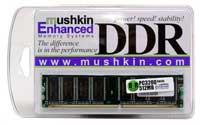Buyer's Guide - Entry Level, January 2005
by Jarred Walton on January 9, 2005 12:05 AM EST- Posted in
- Guides
Memory
Selecting RAM for a budget computer is always difficult. On the one hand, dual-channel memory will help out performance on most of the platforms that we've listed (the exception being the socket 754 system). On the other hand, we hate to recommend 256 MB DIMMs as they are rather on the small side, and two 512 MB DIMMs is too expensive. For the Athlon 64 configuration, a single 512 MB DIMM is an easy choice. The other platforms - particularly the socket A Sempron system - are not so clear cut. If you get two 256 MB DIMMs on socket A and later want to upgrade to 1 GB, you will have to add in a single 512 MB DIMM and end up running in single-channel mode. The Intel platforms both have four DIMM sockets and so, even with 256 MB DIMMs, they can reach 1 GB. For the time being, 512 MB is enough for most tasks, but if you just want a basic system that you can upgrade further in a few months, we would recommend buying a single 512 MB DIMM now and adding a second later rather than starting with two 256 MB modules. Keep that in mind as you look at our memory recommendations because pricing concerns pretty much force us to use 256 MB DIMMs if we want dual-channel support.Something else worth pointing out is that all of the budget systems that we listed before use DDR memory. If you really want a socket 775 Intel configuration, you could also get DDR2 memory support. That might even increase the performance of the integrated graphics, but it will also add quite a bit to the cost. If you're looking at DDR2-533 memory - and there's no point in getting DDR2 any slower than that - the price for non-generic DIMMs is around $60 for 256 MB modules and $110 for 512 MB modules. That's almost twice as much as the value-oriented DDR memory that we're choosing!
RAM Dual-Channel Recommendation: 2x256 MB Corsair Value Select CL3
Price: $68 shipped
For the dual-channel configuration, we have selected Corsair's 256 MB Value Select RAM. The best price that we could find for this RAM was at Newegg, but you can find similarly priced Samsung, Micron, and Infineon RAM at other locations. Corsair is one of the "reliable" RAM manufacturers, and even though the CAS Latency is rated at 3.0, there's a reasonable chance that tweakers could extract more performance from the RAM. The difference in speed between CL3 and CL2.5 RAM is not particularly large, and for a budget system, you would never notice it. Depending on where you live and/or shop, you might be able to find some other brands of memory for a better price. Crucial, Mushkin, GEIL, and Kingston along with the previously mentioned brands are all safe. You could go with other manufacturers like PNY, PDP or Kingmax without too much concern, and even generic RAM will usually work without problems. For peace of mind, however, we prefer to stick with the better known brands. $20 saved is not worth hours of potential headaches in our opinion.
If you really want to cut costs initially, buying one 256 MB DIMM is certainly an option. Windows XP will still run okay with 256 MB of RAM, and adding a second DIMM at a future date is a relatively simple and painless upgrade. Multitasking will begin to take a pretty noticeable performance hit when you drop down to 256 MB of RAM, but if you usually only run one application at a time, it can get the job done. We don't recommend this option to most people, but it's still there should you want it.
RAM Single-Channel Recommendation: 1x512 MB Mushkin CL2.5
Price: $70 shipped
For the single-channel option (socket 754), we recommend getting one larger DIMM instead of two smaller DIMMs. While it ends up costing $2 more, note that we now get CL2.5 latency instead of CL3 RAM. The performance difference really isn't that great, but CL2.5 256 MB modules would have cost another $10 while here, it's basically "free". The same brand recommendations apply, and if you're willing to risk generic memory, you could get it for as little as $45 to $50. Again, we prefer to spend a little more and have some guarantee of reliability.
While it's not really a budget option, you could also get two of these 512 MB DIMMs and run with a full gigabyte of memory. It's definitely more of a luxury than a requirement for typical computing use, but at the same time, you rarely have to worry about running out of memory even in heavy multitasking scenarios. (Graphics artists, of course, can always use more memory, so the previous statement isn't directed at them.) As we mentioned before, starting with a single 512 MB DIMM and adding a second module in a few months is a good plan if money is tight right now, but you know you'll want more than 512 MB of memory down the road.












31 Comments
View All Comments
mcveigh - Sunday, January 9, 2005 - link
nice selection, I love the SFF choices.